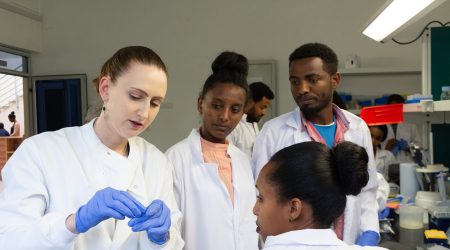Unexpected discovery opens bioengineering opportunities for human and plant health

An unexpected genetic discovery in wheat has led to opportunities for metabolic engineering of versatile compounds with potential to improve its nutritional qualities and resilience to disease.
Researchers in the Osbourn group at the John Innes Centre have been investigating biosynthetic gene clusters in wheat – groups of genes that are co-localized on the genome and work together to produce specific molecules.
In a study which appears in Nature Communications, they identified a gene cluster activated by pathogen infection, which was found to produce a compound they named triticein.
Experiments to determine the structure of triticein surprisingly identified this compound as an isoflavone rather than a flavone, as the team had expected.
Isoflavones are a class of phytoestrogen compounds well studied for their benefits to human health, which include prevention of cardiovascular disease and some cancers. They are mostly found in the legume family of which soybeans are the main source in the human diet.
The discovery of an alternative route to isoflavonoid biosynthesis, this time in wheat, and the elucidation of the triticein biosynthetic pathway in this study, provides exciting opportunities for future research and paves the way for metabolic engineering efforts. Increasing triticein production in wheat, for example, may aid in developing cultivars with higher disease tolerance.
Another possibility is that wheat triticein-forming genes can be expressed in other plants or microbes, from which the molecule can be produced, and its antimicrobial properties further investigated. And because triticein is an isoflavone there is a possibility that it may have health benefits like others in this class, although there is much further research to be done on this prospect.
Dr. Rajesh Chandra Misra, a post-doctoral scientist at the John Innes Centre and one of the lead authors explained: “We do not know anything specifically about potential health benefits of triticein, only about other isoflavones. Also, the concentrations of triticein (and other isoflavones) that we found in wheat grains were very low, so wheat cannot be currently considered as a source of dietary isoflavones.”
Joint lead author Dr Guy Polturak previously at the John Innes Centre and now at The Hebrew University of Jerusalem reflected: “This study is a nice example of how scientific research sometimes takes scientists down unintended paths, eventually leading to unexpected discoveries. The main aim of this research was to learn about wheat chemical defence mechanisms, but it led to interesting new findings on plant biochemistry, in this case the discovery of a unique isoflavone synthase.”
Discovery of isoflavone phytoalexins in wheat reveal an alternative route to isoflavonoid biosynthesis, appears in Nature Communications.



